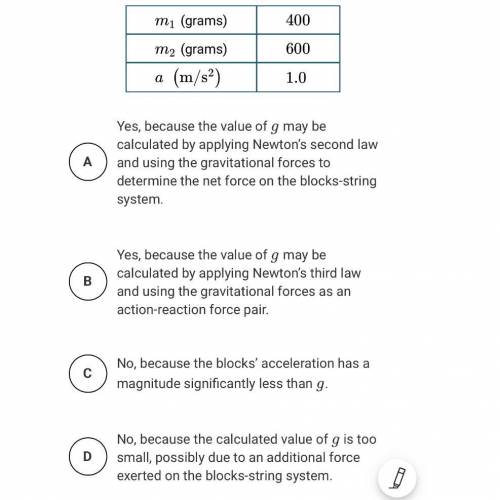
Physics, 20.02.2020 09:41 jacksoneaton
Two students wish to determine the value of g, the acceleration due to gravity at Earth’s surface. The students have a collection of blocks of different masses, a string of negligible mass, a pulley of negligible mass, and a device for measuring acceleration. The students attach two of the blocks to the ends of the string and pass the string over the pulley so the blocks hang vertically on either side. The blocks are then released from rest, and their acceleration is measured. The students’ data for one trial are shown below, with m1 and m2 equal to the masses of the blocks. Considering the gravitational forces acting on the blocks, do the data provide a reasonable determination of the value of g, and what is a possible justification for why or why not?


Answers: 1


Another question on Physics

Physics, 22.06.2019 03:50
The force acting on a beam was measured under the same operating conditions and a sample of 5 data points was collected. this process was repeated by 3 observers. the pooled standard deviations of these 3 data sets was 1.21. determine the true mean force using all pooled data (with a 95% probability). the result should look like this: true mean = mean +/- margin of error
Answers: 1

Physics, 22.06.2019 08:40
The system is released from rest with the cable taut, and the homogeneous cylinder does not slip on the rough incline. determine the angular acceleration of the cylinder and the minimum coeffi cient s of friction for which the cylinder will not slip.
Answers: 2

Physics, 22.06.2019 18:30
What would people living along the coast in south florida do if there was a hurricane warning? move to locations away from the water flock along coasts to watch the natural phenomenon buy instruments to predict the exact location of the hurricane measure water levels to know the exact time of the hurricane
Answers: 3

Physics, 23.06.2019 01:30
The flame produced by the burner of a gas (propane) grill is a pale blue color when enough air mixes with the propane (c3h8) to burn it completely. for every gram of propane that flows through the burner, what volume of air is needed to burn it completely? assume that the temperature of the burner is 195.0°c, the pressure is 1.05 atm, and the mole fraction of o2 in air is 0.210.
Answers: 2
You know the right answer?
Two students wish to determine the value of g, the acceleration due to gravity at Earth’s surface. T...
Questions

Social Studies, 07.11.2019 17:31


Social Studies, 07.11.2019 17:31


Mathematics, 07.11.2019 17:31


Mathematics, 07.11.2019 17:31

History, 07.11.2019 17:31

History, 07.11.2019 17:31


Mathematics, 07.11.2019 17:31


Spanish, 07.11.2019 17:31

Geography, 07.11.2019 17:31

Chemistry, 07.11.2019 17:31

History, 07.11.2019 17:31




Mathematics, 07.11.2019 17:31

 (2)
(2) is the weight of block m2, with
is the weight of block m2, with is the mass
is the mass is the acceleration due to gravity
is the acceleration due to gravity is the acceleration measured
is the acceleration measured (1)
(1) is the weight of block m1, with
is the weight of block m1, with mass of m1
mass of m1

 : so the correct answer is
: so the correct answer is

